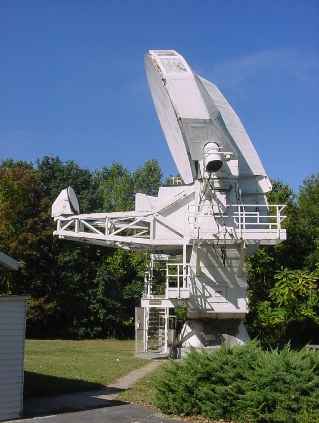Ku-band Polarization Identifier at the University of Miami
As part of the family of CMB polarization experiments, KUPID is a 12-18GHz (Ku-band) receiver that is currently being built at the University of Miami in collaboration with Princeton University and University of Chicago. It will be integrated on the existing Crawford Hill 7-meter offset cassegrainian antenna, shown in the picture below. As a polarimeter, it is configured to measure both Q and U Stokes parameters, and it will also measure the brightness temperature of left and right circular polarization. When the latter measurements are spatially differenced, they can be used to measure ΔT, as a sensitive differential radiometer. With these capabilities, KUPID will perform a variety of studies that span the interstellar medium to cosmology.
So you might ask, why the Ku-band? Well, the reasons are:
- Polarized synchrotron emission is expected to be sizable at these frequencies;
- Very little mapping of the diffuse polarization has been performed at 12-18 GHz;
- This band is complementary to the higher frequency bands of the MAP satellite that extend from 22 to 90 GHz;
- This band straddles the peak of the hypothesized spinning dust foreground.
Therefore, KUPID science goals include:The 7 meter Crawford Hill Telescope
- Survey the polarized component of galactic synchrotron radiation;
- Characterize the anomalous foreground emission – hypothesized to be spinning dust;
- Measure CMB polarization, if foregrounds are not too limiting;
- Perform follow-up measurements of interesting regions identified by the MAP satellite;

There are also technical/practical reasons to prefer Ku-band:
- A simple homodyne system can be incorporated with no waveguide components (except the horn, the OMT and the quadrature hybrid)
- Similar components used in the intermediate frequency (IF) portions of PIQUE/CAPMAP can be also incorporated in this system;
- Very low noise, amplifiers are available in the Ku-band from the National Radio Astronomy Observatory.
The Univ. of Miami team working on KUPID consists of:
Dr. Joshua Gundersen
j.gundersen@miami.edu
305-284-2323 ext.6
Graduate student Eugenia Ştefǎnescu
Undergraduate student Yunior Savon
Undergraduate student David Leibovitch
This material is based upon work supported by the National Science Foundation under Grant No. 0206241. Any opinions, findings and conclusions or recomendations expressed in this material are those of the author(s) and do not necessarily reflect the views of the National Science Foundation (NSF).




